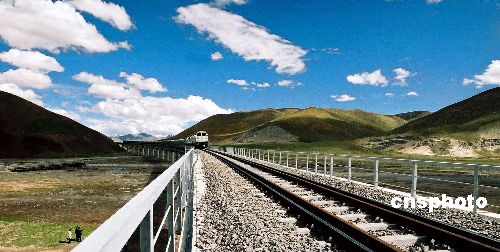Rich mines found along Qinghai-Tibet Railway |
文章来源: 文章作者: 发布时间:2007-01-26 06:11 字体: [ 大 中 小] 进入论坛 |
(单词翻译:双击或拖选)
|
|

| The massive land resources survey started in 1999 has discovered 16 rich mines along the Qinghai-Tibet Railway. |
| Chinanews, Beijing, January 26 – The massive land resources survey started in 1999 has discovered 16 rich mines along the Qinghai-Tibet Railway.
“These mines, plus those found in Xinjiang, Yunnan and Guangdong, will be important support to the new nonferrous metal bases, and will ease the great demand for mineral resources, ” said Meng Xianlai, the director of China Geological Survey.
Now, five nonferrous metal mine lots have been formed along the Qinghai-Tibet Railway. It is estimated that the copper1 reserves in the mine lot is some 20 million tons and that of lead and zinc2 is 10 million tons respectively. At present, 7.98 million tons of copper reserve have been proved in a copper mine in Maizho, making it the second largest of its kind in China.
|
点击  收听单词发音
1
copper

|
|
| n.铜;铜币;铜器;adj.铜(制)的;(紫)铜色的 |
参考例句: |
- The students are asked to prove the purity of copper.要求学生们检验铜的纯度。
- Copper is a good medium for the conduction of heat and electricity.铜是热和电的良导体。
|
2
zinc

|
|
| n.锌;vt.在...上镀锌 |
参考例句: |
- Brass is formed by the fusion of copper and zinc.黄铜是通过铜和锌的熔合而成的。
- Zinc is used to protect other metals from corrosion.锌被用来保护其他金属不受腐蚀。
|
|
|
|
|
 收听单词发音
收听单词发音 
